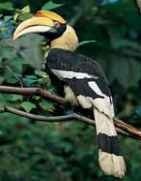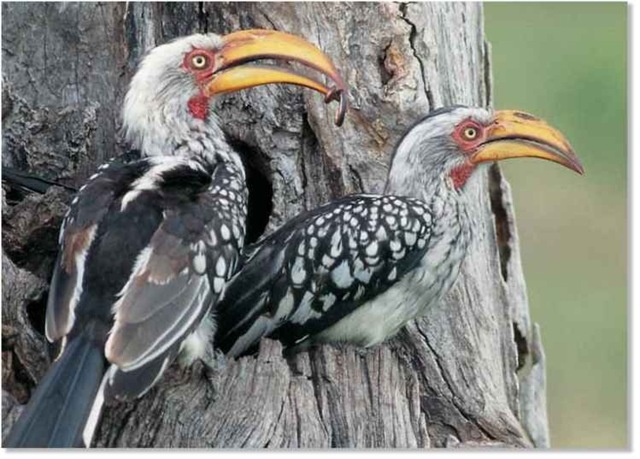ORDER
Coraciiformes
FAMILY
Bucerotidae
GENUS & SPECIES
key features
• Male takes total responsibility for feeding female and chicks during the breeding period
• Female and young are sealed in their nest hole with a wall of dried mud to keep out predators
• Achieves far greater fledging success than other hole-nesting birds that don’t seal the nest
where in the world?
From Angola through Namibia to Zambia, Botswana, Zimbabwe, Malawi, northern and eastern South Africa and southwestern Mozambique

LIFECYCLE
The southern yellow-billed hornbill goes to great lengths to safeguard its eggs and young, with male and female contributing equally to this family partnership.
HABITAT

A Balancing act A thorn bush provides a perch for the southern yellow-billed hornbill.
The southern yellow-billed hornbill can thrive in several habitats. It finds a home on the savannah, among scattered trees and thorn bushes. The bird also lives in open woodlands. In semiarid areas, its usually found in waterside vegetation, but the hornbill avoids locations where the grass and undergrowth are especially tall and dense.
Although the southern yellow-billed hornbill doesn’t migrate, it sometimes moves in dry seasons from the flat lowlands to moister, verdant hillsides. More local movements are sometimes prompted by the chance to take advantage of a good food source — such as bird feeders at game lodges. Under such circumstances, the bird will usually fly back to its usual territory to roost each night.
The bird’s strange nesting habits have earned it a place in African folklore, where it’s often revered as a symbol of marital fidelity.
Bill color may result from diet. Captive birds gain even brighter bills when fed pigment-rich food, such as egg yolk and tomatoes.
CONSERVATION
The southern yellow-billed hornbill is widespread and common over most of its range.There’s concern, however, about the long-term future of these and other hornbills as relentless land misuse steadily reduces their habitat.
FOOD & FEEDING
Insects, caught in the bill tip and tossed into the mouth with a flick of the head, form the bulk of the hornbill’s diet. Beetles, termites, grasshoppers and caterpillars are staple items.
The southern yellow-billed hornbill is one of the least fussy of eaters and welcomes the opportunity to dine on rodents, small snakes, eggs, scorpions and ants. The bird balances its diet by eating seeds and fruits, including the nutritious nuts of the oil palm.
Most foraging is done on the ground, where prey is snapped up with little effort.The bird will also dig into soil and lift rocks with its bill in search of food. Safari tourist camps are often visited by groups of hornbills looking for scraps or handouts.
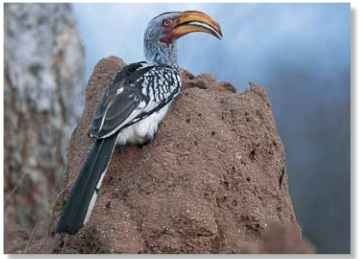
A Termite delight The hornbill snaps up termites in its long bill.
Snake snack The hornbill readily attacks and devours small snakes.
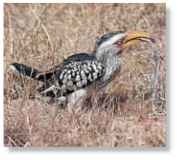
BREEDING
Pairs begin nesting with the October rainy season. They become increasingly vocal and display to each other by bowing and fanning their wings above their backs. Adults nest in a hole 16-40′ up in a tree. Both sexes seal the entrance, but the female does most of the work from within. With mud brought by the male, she uses her bill to build a wall. She leaves a slit through which her mate delivers food and out of which she ejects remains of food and droppings.
The confined female first lays her eggs, then molts all ‘ flight and tail feathers at once; if her mate deserts her or dies now, the family is doomed. Chicks hatch at intervals. When the eldest is about three weeks old, the newly feathered female escapes the nest by breaking down the wall. The parents and young repair the wall with their droppings. Both parents bring food to the chicks for the next six weeks.
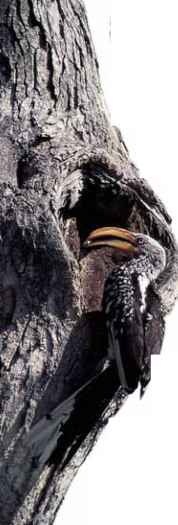
Count on me While the incubating female is walled up in the nest, she relies on her mate to bring her food.
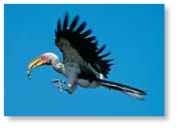
AS SAFE AS FORT KNOX
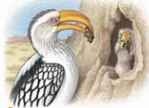
Sealing in…
The female uses her bill as a trowel, walling up the entrance to her nest with mud provided by her mate.
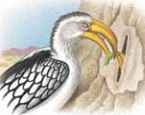
Provisions…
The imprisoned female depends on the male for food, which he passes through the slit in the wall.
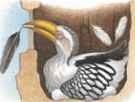
Confinement…
Secure in her nest, the female becomes flightless as she molts, throwing out most of the feathers.
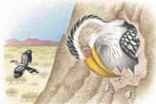
Breaking out
After a confinement of about 50 days, the female chisels out to help her mate feed the chicks.
BEHAVIOR
The southern yellow-billed hornbill is a sedentary bird. Where conditions are particularly suitable, there may be as many as 6 breeding pairs in a half-mile square, each in its own territory.
Outside the breeding season, the species is usually in pairs or small family parties.They forage together and sleep communally in trees. Birds maintain contact with each other by making clucking calls, which become louder if they’re alarmed by a predator
Mongooses and many birds of prey hunt the southern yellow-billed hornbill. Adults frequently fall victim to eagles, falcons and owls; the chicks, in their walled nest, are safe from most predators.
In her breeding confinement, the female spends much of her time with one eye against the entrance slit, keeping watch.
Two’s company
The bird is usually seen paired or in a small group.
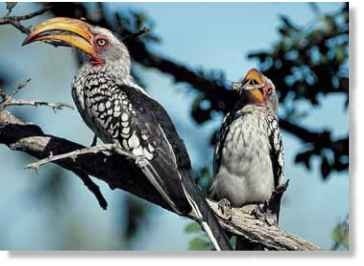
PROFILE
Southern Yellow-billed Hornbill
The huge bill, typical of the hornbill family, serves as a trowel for walling up the nest and as surprisingly delicate tweezers for picking up food.
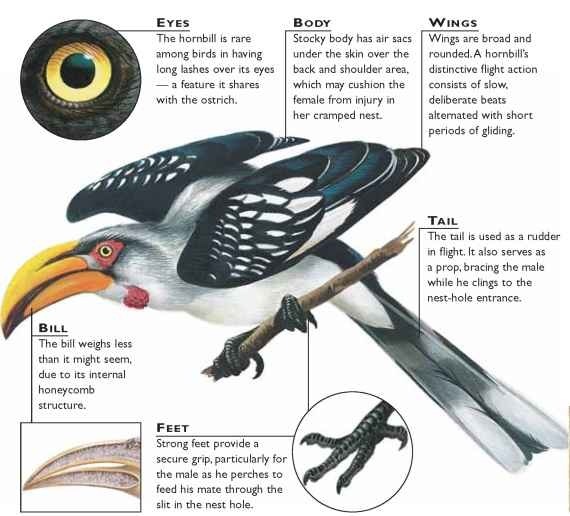
CREATURE COMPARISONS
Big, powerful curved bills for snapping up prey are a feature of the hornbill family The southern yellow-billed hornbill eats mainly insects, plucked from the ground.
The southern ground hornbill’s much larger bill is a formidable weapon, capable of dealing a death blow to animals as large as hares, squirrels and snakes.
The hornbills and their New World equivalents, the toucans, are unrelated, but have evolved similarly shaped bills because of their similar feeding habits.

Southern yellow-billed hornbill

Southern ground hornbill

| VITAL Weight |
STATISTICS 5-8 oz. |
| Length | 16-18″ |
| Wingspan | 24-26″ |
| Sexual Maturity | 1 year |
| Breeding Season | Mainly October -February |
| Number of Eggs | 2-6; usually 3 or 4 |
| Incubation period |
24 days |
| Fledging Period | 42-47 days |
| Breeding Interval | 1 year |
| Typical Diet Lifespan |
Insects, eggs, rodents, small snakes, fruit and seeds Probably 35-40 years |
Related species
• The 54 hornbill species are all found in the Old World, mostly in tropical regions. They include the 5′-long great pied hornbill (below).
